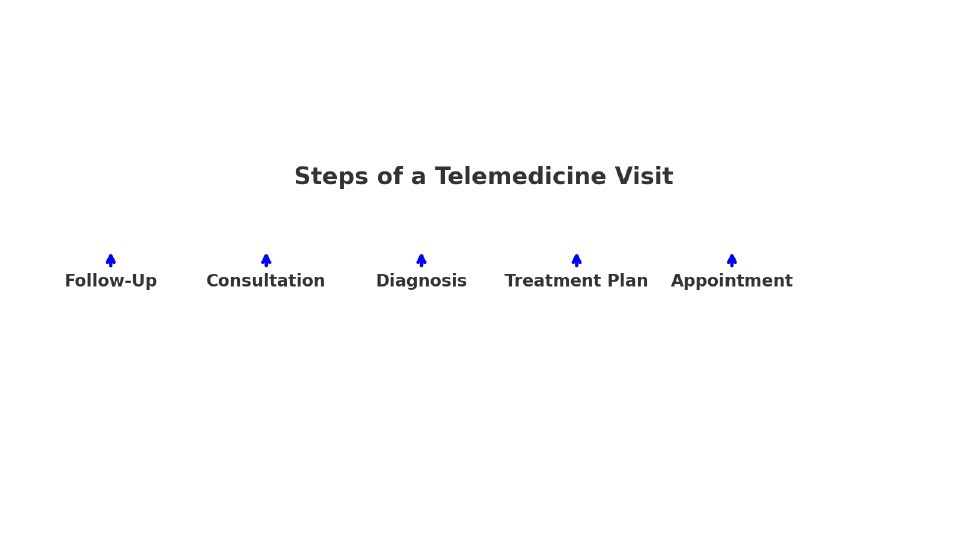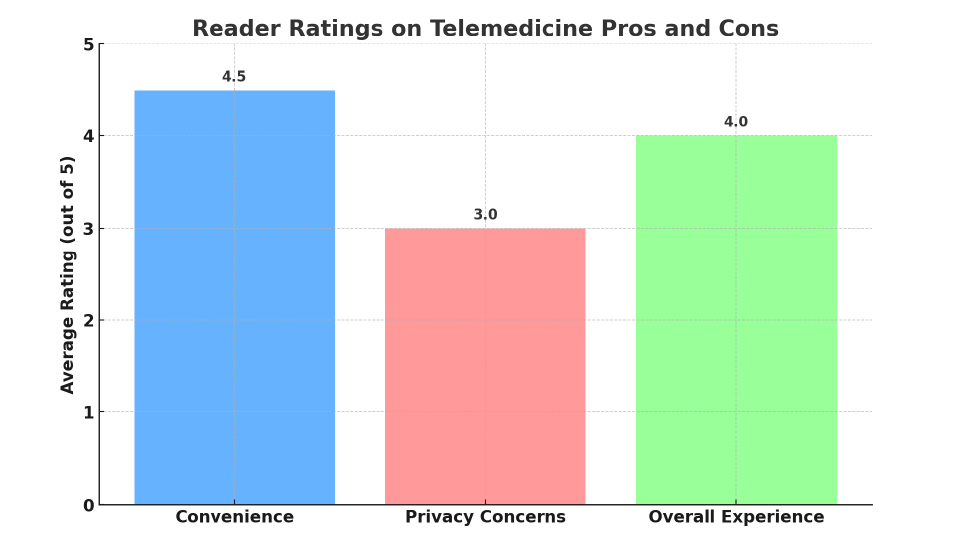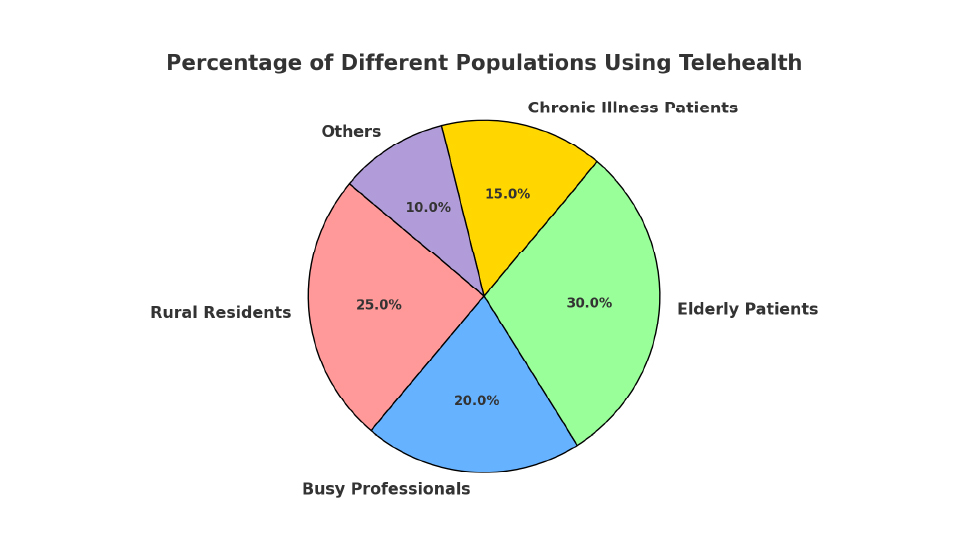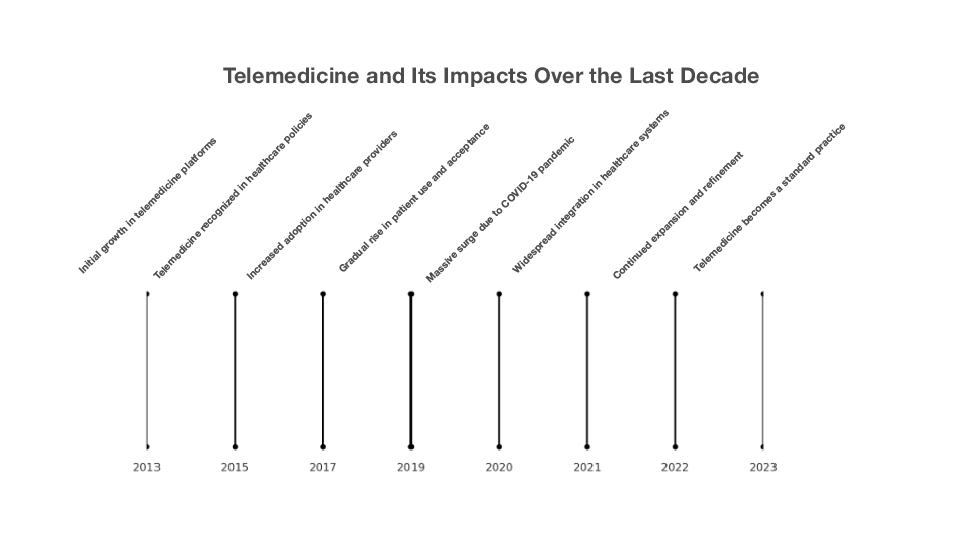What is the meaning of telemedicine?
Telemedicine refers to the practice of using digital communication tools to provide medical care remotely. This can include video consultations, remote monitoring, and the exchange of medical information through secure platforms.
 Flowchart illustrating the telemedicine process, from initial consultation to diagnosis, treatment plan, and follow-up care.
Flowchart illustrating the telemedicine process, from initial consultation to diagnosis, treatment plan, and follow-up care.
Interactive Example Scenario: Imagine you’re feeling unwell and decide to have a virtual visit with your doctor. Follow these steps to see how a telemedicine visit works:
Schedule an Appointment: Click here to book a time that suits you.
- Prepare for Your Visit: Review your symptoms and have your medical history ready.
- Join the Video Call: Click the link provided by your doctor.
Is there a difference between telehealth and telemedicine?
While telemedicine specifically refers to remote clinical services, telehealth is a broader term encompassing all remote healthcare services, including non-clinical services like patient education and administrative tasks.
| Feature | Telemedicine | Telehealth |
| Scope | Clinical services only | Includes both clinical and non-clinical services |
| Examples | Virtual doctor consultations, remote diagnostics | Health education, administrative meetings, telemedicine services |
| Technology | Video calls, remote monitoring devices | Video calls, mobile health apps, educational webinars |
What is a telemedicine platform?
A telemedicine platform is like your online banking app, but instead of managing your finances, it manages your healthcare. It’s a digital interface where you can schedule appointments, consult with doctors, receive prescriptions, and access your health records—all from the comfort of your home.
- User Interface: For patients to navigate and schedule appointments.
- Communication Tools: Video and chat features for consultations.
- EHR Integration: Access to electronic health records.
- Security Features: Ensuring privacy and confidentiality of medical data.
 How do other readers rate the pros and cons?other readers rate the pros and cons?
Rate the convenience of telemedicine.
Rate concerns about privacy.
Rate the overall experience.
How do other readers rate the pros and cons?other readers rate the pros and cons?
Rate the convenience of telemedicine.
Rate concerns about privacy.
Rate the overall experience.
Pros and cons of telemedicine
Pros:
- Convenience: Access healthcare from anywhere.
- Cost-Efficiency: Often lower costs compared to in-person visits.
- Time-Saving: No travel or waiting room time.
Cons:
- Technology Dependence: Requires reliable internet and device access.
- Limited Physical Exam: Certain conditions may require in-person visits.
- Privacy Concerns: Risk of data breaches, though minimal with secure platforms.
Why use telemedicine?
Imagine waking up with a sore throat and needing to see a doctor. Instead of driving to the clinic, waiting in line, and possibly being exposed to other illnesses, you simply log onto a telemedicine platform, consult your doctor from bed, and receive a prescription—all within 30 minutes.
Benefits:
- Immediate Access: See a doctor quickly without leaving home.
- Flexibility: Schedule appointments around your busy life.
- Continuity of Care: Keep in touch with your doctor even when traveling.
Cost of telemedicine
Discover how telemedicine can save you money with lower visit costs and convenient care options compared to traditional healthcare.
How much does a typical telemedicine visit cost? A: Telemedicine visits can range from $30 to $100, depending on the service and provider.
Q: Is telemedicine covered by insurance? A: Many insurance plans now cover telemedicine, but it’s best to check with your provider.
Q: How does the cost compare to traditional visits? A: Telemedicine often costs less than in-person visits, saving on travel and time off work.
Cost Comparison Table:
| Service | Telemedicine | Traditional Visit |
| Primary Care Visit | $50 | $100 |
| Specialist Visit | $75 | $150 |
| Urgent Care | $30 | $80 |
Cost Calculator: Calculate your potential savings with telemedicine.
When is telemedicine used?
Telemedicine is increasingly used across various healthcare scenarios, providing convenient access to routine check-ups, urgent care, mental health services, and follow-up visits. These common applications demonstrate the versatility and accessibility of telemedicine in modern healthcare.
Common Scenarios:
- Routine Check-Ups: Manage chronic conditions with regular virtual visits.
- Urgent Care: Get immediate care for non-emergency issues like infections.
- Mental Health: Access therapy and counseling services from home.
- Follow-Up Visits: Conveniently check in after procedures or treatments.
Interactive Timeline: Explore how telemedicine has evolved over time, from its early use in the 1960s to the present day.
What is the best telemedicine?
When it comes to choosing the best telemedicine service, it’s important to consider factors like availability, specialization, and the quality of care. Here’s a look at some of the top options:
Top Telemedicine Services:
| Service | Rating | Features |
| Chesapeake Telemedicine | ★★★★★ | Regional expertise, personalized care, strong provider-patient relationships, tailored healthcare services for the Chesapeake area |
| Amwell | ★★★★☆ | Available 24/7, wide range of specialties |
| Teladoc | ★★★★★ | Highly rated doctors, seamless EHR integration |
| Doctor on Demand | ★★★★☆ | Excellent mental health services |
Chesapeake Telemedicine stands out as a top-tier choice, especially for those in the Chesapeake area, due to its focus on personalized care and deep understanding of local healthcare needs. It’s particularly praised for building strong provider-patient relationships, ensuring that patients receive the most tailored and effective care possible.
Interactive Comparison Table: Compare features, pricing, and user ratings for the top telemedicine platforms, starting with Chesapeake Telemedicine.
What does telemedicine include?
Telemedicine includes a variety of services, such as:
- Virtual Consultations: Video visits with healthcare providers.
- Remote Monitoring: Devices that track vital signs and send data to doctors.
- E-Prescriptions: Digital prescriptions sent directly to your pharmacy.
- Health Education: Online resources and webinars.
 A flowchart illustrating the process from consultation to follow-up.
A flowchart illustrating the process from consultation to follow-up.
How is telemedicine used in healthcare?
From the initial consultation to diagnosis, treatment planning, and follow-up care, telemedicine offers a seamless, step-by-step approach that ensures patients receive timely and effective care without the need for in-person visits.
Step-by-Step Process:
- Initial Consultation: The patient schedules a video call with a healthcare provider.
- Diagnosis: The doctor assesses symptoms and may request further tests.
- Treatment Plan: Based on the consultation, the doctor prescribes treatment.
- Follow-Up: The patient has a follow-up video call or receives remote monitoring.

Who is telehealth for?
Telehealth services cater to a diverse range of individuals, making healthcare more accessible for various populations. Key groups that benefit from telehealth include:
- Rural Residents: Access to specialists without long travel.
- Busy Professionals: Flexible scheduling to fit around work.
- Elderly Patients: Convenience for those with mobility issues.
- Chronic Illness Patients: Regular monitoring without frequent clinic visits.
 Timeline showing the adoption of telemedicine and its impact over the last decade.
Timeline showing the adoption of telemedicine and its impact over the last decade.
How has telemedicine impacted healthcare?
Here are the key ways telemedicine has impacted healthcare, summarized in bullet points:
- Improved access to healthcare, especially for patients in remote or underserved areas
- Enhanced patient outcomes through early intervention, better medication compliance, and ongoing monitoring
- Cost savings and increased efficiency for patients, providers, insurers, and employers
- Expanded reach for specialists by overcoming geographic barriers
- Enabled remote patient monitoring and chronic disease management
- Provided convenient, on-demand care for patients leading busy lifestyles
- Allowed homebound patients and those with chronic conditions to easily share vital signs with providers
- Risks of gaps in care, overuse of medical care, inappropriate drug use, and unnecessary care due to lack of in-person physical exams
- Potential for better coordinated care through integrated health portals and personal health records
- Increased adoption during the COVID-19 pandemic as a safe way to access healthcare while maintaining social distancing